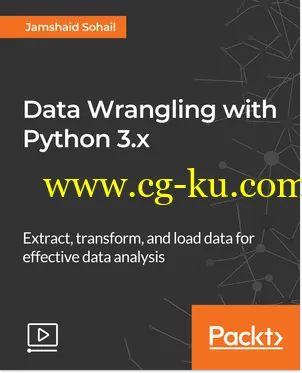$125 | Duration: 3h 35m | Video: h264, 1920×1080 | Audio: AAC, 48kHz, 2 Ch | 1.1 GBGenre: eLearning | Language: English | January 31, 2019Learn the data life cycle—from acquisition to processing to analysis—in PythonVideo DescriptionYou might be working in an organization, or have your own business, where data is being generated continuously (structured or unstructured) and you are looking to develop your skillset so you can jump into the field of Data Science.
This hands-on guide shows non-programmers like you how to process information that’s initially too messy or difficult to access.
In this course, you will gather data, prepare data for analysis, perform simple statistical analyses, create meaningful data visualizations, and more! This course will equip you with the tools and technologies you need to analyze datasets (real-life datasets containing lots of anomalies) using Python so that you can confidently jump into the field and enhance your skillset.
The best part of this course is the take-away code templates generated using the real-life dataset.
Towards the end of the course, you’ll build an intuitive understanding of all the aspects available in Python for Data Wrangling.
By the end of this course, you will be comfortable with using R and its associated libraries to solve any problem associated with quantitative finance.
All codes and supporting files are placed on GitHub at this link:Style and ApproachThis hands-on course demonstrates concepts via slides, to make sure they’re explained in simple ways.
Throughout the course, we will be using datasets downloaded from Kaggle and other sources on the public web for concepts practical intuition.
We will also be creating a GitHub repo throughout the whole course, to help you maintain a good profile on GitHub and use those code templates in other problems.
We also provide coding assignments because practice makes perfect.
Table of ContentsGATHERING AND PARSING DATAWORKING WITH DATA FROM EXCEL AND PDF FILESSTORING DATA IN PERSISTENT STORAGECLEANING STRUCTURED DATAMORE DATA CLEANING AND TRANSFORMATIONPERFORMING STATISTICAL ANALYSISLET THE VISUALIZATIONS TELL THE STORYWhat You Will LearnEffectively pre-process data (structured or unstructured) before doing any analysis on the dataset.
Retrieving data from different data sources (CSV, JSON, XML, Excel, PDF) and parse them in Python to give them a meaningful shape.
Learn about the amazing data storage places in an industry which are being highly optimized.
Perform statistical analysis using in-built Python libraries.
Different techniques used to get meaningful insights out of unstructured dataHacks, tips, and techniques that will be invaluable throughout your Data Science career.
AuthorsJamshaid SohailJamshaid Sohail is a Data Scientist who is highly passionate about Data Science, Machine learning, Deep Learning, big data, and other related fields.
He spends his free time learning more about the field and learning to use its emerging tools and technologies.
He is always looking for new ways to share his knowledge with other people and add value to other people’s lives.
He has also attended Cambridge University for a summer course in Computer Science where he studied under great professors and would like to impart this knowledge to others.
He has extensive experience as a Data Scientist in a US-based company.
In short, he would be extremely delighted to educate and share knowledge with, other people.

